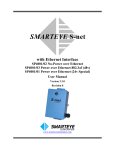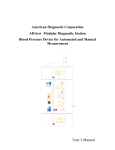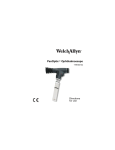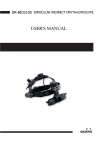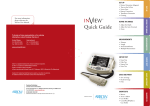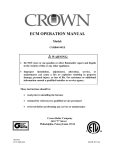Download ADC® Otoscope / Ophthalmoscope Instrument Set
Transcript
ADC Otoscope / Ophthalmoscope Instrument Set ® Use, Care and Maintenance ® Thank you for choosing an ADC® Diagnostc Instrument Set. We’re proud of the care and quality that goes into the manufacture of each and every diagnostic instrument that bears our name. Every component has been carefully designed to maximize performance. (For item 5212, also used in 5210, 5215, 5211, 5211V) Device Description and Intended Use The ophthalmoscope is a handheld, battery-powered device containing illumination and viewing optics intended to examine the media (cornea, aqueous, lens, and vitreous) and the retina of the eye. It is intended to be used by a trained healthcare professional. Otoscope Attachment (5210 and 5215) - The otoscope is a handheld battery powered device with magnifying system that provides illumination of the ear canal and tympanic membrane. Nasal Speculum Adapter for Otoscope Attachment (5215 only) - When using the otoscope attachment with a nasal speculum adapter, the device allows for direct examination of the nares while maintaining a line of sight. Bent Arm Illuminator (5215 only) - The bent arm illuminator is a handheld light that can be used to illuminate a patient’s mouth and upper throat during an examination. The bent arm illuminator is a non-invasive light source designed to facilitate the examination of the oropharynx area. It can also be used to assist in assessing papillary light response and for transillumination of the sinuses. When used with laryngeal mirrors, it allows for non invasive, indirect visualization of the hypopharynx. Latex Statement - This device and all accessories are latex free. This device should be used by a trained healthcare professional. Contraindications The use of this device is contraindicated in patients who have already received prolonged or intense light exposure, especially if the patients are infants, aphakes, or persons with diseased eyes. Excessive exposure to light may result in patient injury. See warnings for additional information. General Warnings A warning statement in this manual identifies a condition or practice which, if not corrected or discontinued immediately, could lead to patient injury, illness, or death. CAUTION: Because prolonged intense light exposure can damage the retina, the use of the device for ocular examination should not be unnecessarily prolonged, and the brightness setting should not exceed what is needed to provide clear visualization of the target structures. The retinal exposure dose for a photochemical hazard is a product of the radiance and the exposure time. If the value of radiance were reduced in half, twice the time would be needed to reach the maximum exposure limit. While no acute optical radiation hazards have been identified for direct or indirect ophthalmoscopes, it is recommended that the intensity of light directed into the patient's eye be limited to the minimum level which is necessary for diagnosis. Infants, aphakes and persons with diseased eyes will be at greater risk. The risk may also be increased if the person being examined has had any exposure with the same instrument or any other ophthalmic instrument using a visible light source during the previous 24 hours. This will apply particularly if the eye has been exposed to retinal photography. WARNING: The carrying cases provided with these devices are intended for long term storage or transport between facilities or when shipping devices to and from ADC’s facility for repair or servicing. Carry cases (including internal liners) can NOT be cleaned or disinfected and should be safely discarded if contaminated. Do not carry the case into a contaminated environment. WARNING: When replacing lamp, allow lamp to cool for five minutes before handling. WARNING: When cleaning/disinfecting devices that have been used on patients, be sure to use appropriate personal protective equipment and follow all safety precautions/warnings. CAUTION: Consult the cleaning and disinfection instructions for each part for further information about cleaning and disinfecting this product. Always remove batteries prior to cleaning or disinfecting any device. WARNING: No form of sterilization has been validated for this device or its corresponding components and sterilization may compromise the safety and effectiveness of this device. (This includes steam sterilization.) WARNING: Use of any accessories or materials not indicated in the user's manual can degrade the minimum safety of the equipment. CAUTION: Federal law restricts this device to sale by or on the order of a physician or licensed health care practitioner. WARNING: During use metal components near instrument head can become warm. This is especially true if device is on for extended periods of time. Do not leave device on when not in use. Otoscope This instruction manual is for use with the Complete 2.5v Instrument Set (Item #5215), 2.5v Diagnostic Set (Item #5210), 2.5v Otoscope (Item #5211 or 5211V), and all accessories and replacement parts. Battery Handle: (Item #5211-5) All instrument sets come equipped with a "C" cell knurled chrome handle with rheostatic power switch. Battery Replacement Requires 2 "C" cell batteries. Remove the knurled cap at the base of the handle by turning counterclockwise. Insert two fresh "C" cell batteries (not included) with the positive polarity towards the instrument head. Replace battery compartment cap by turning clockwise. (Fig. 1). Removing and Attaching the Instrument Head All instrument heads feature a bayonet style mount. To remove, push down firmly and rotate counterclockwise. To engage, align slots on base of instrument head with tabs on bayonet. Push head and twist clockwise until engaged. (Fig. 2). Turning the Instrument On To illuminate, press the white power switch and rotate the rheostatic bezel clockwise until desired lamp intensity is obtained (0 position is off, red 1 position is full power) Slide the switch in the opposite direction to turn off. (Fig. 3). (Fig. 1) (Fig. 2) (Fig. 3) Handle Care and Maintenance The handle can be cleaned following the guidelines in the ‘Cleaning and Disinfection’ section below. Periodically check the condition of the batteries, making sure there is no sign of corrosion or oxidation. Always replace BOTH batteries. Alkaline batteries are recommended. Remove batteries from handle if instrument will not be used for an extended period of time. Instrument heads Otoscope Head (provided on 5215, 5210, 5211, and 5211V) (Item #5220). This instrument head is designed for examination of the ear canal – specifically the external acoustic duct and tympanic membrane. The head comes complete with a 3x removable viewing lens, insufflator fitting, and 3 reusable specula (standard models with 2.5mm, 3.5mm, and 4.5mm specula; veterinary model with 4mm, 5mm, and 7mm specula). Attaching the specula Push the flanged end of the desired speculum onto the instrument head aligning the slot in the speculum flange with the rivet at the top of the instrument head and twist clockwise to engage. Reverse procedure to remove. (Fig.4) Using Welch Allyn or equivalent disposable specula: Attach the disposable specula adaptor, Item #5211-AD in the same manner as the reusable specula. Attach Welch Allyn or equivalent disposable speculum by pushing the flanged end of the desired speculum onto the chrome socket and twist counterclockwise to engage (Fig.4b). Reverse procedure to remove and discard after each use. (Fig. 4) (Fig. 4b) (Fig. 5) (Fig. 6) (Fig. 7) Removing Viewing lens To remove the Viewing lens (Item #5211-L) during an examination, rotate lens counterclockwise and pull. Reverse procedure to attach. (Fig. 5). Replacing lamp Remove speculum. Pull black sleeve off of lamp. Twist lamp counterclockwise to remove. Replace with ADC Item #5211-4. Reverse procedure to install new lamp. (Fig. 6). Insufflator The unit comes equipped with an insufflator fitting already attached. The insufflator bulb and tubing (Item #5122N) can be purchased separately. (Fig. 7). Ophthalmoscope (provided on set #5215 and #5210) This instrument head (Item #5240) is equipped with 24 lenses from -25 to +40 diopters. (Fig. 8). (Fig. 8) (Fig. 9) Corrective lens selection: Unit is equipped with 24 corrective lenses from +40 to -25 diopters (negative lenses in red). To select, rotate the corrective lens selection wheel at either side of the instrument head. Selected lenses can be viewed in the illuminated panel on practitioner’s side of the instrument. (Fig. 9). (Fig. 10) Replacing Halogen lamp: Remove the Ophthalmoscope head by turning counterclockwise. Grab end of lamp from inside base of Ophthalmoscope head and remove. Replace with new lamp (Item #5210-4), taking care not to touch the glass, and align lamp metal guides on side of lamp with grooves in lamp socket. (Fig. 10). Bent Arm Illuminator Head: (Item #5215-TH) This instrument head is designed for examination of the oral cavity in conjunction with the tongue depressor blade, or laryngeal mirror attachments. Supplied attachments include a reusable tongue blade (Item #5215-TD), adapter for dis(Fig. 11) posable tongue blade (Item #5215-TO), 3mm laryngeal mirror (Item #5215M3), and 4mm laryngeal mirror (Item #5215-M4). These attachments are supplied with complete set (Item #5215) only or can be purchased separately. (Fig. 11). Attaching any of the supplied Attachments Align slot on attachment with pin on top surface of bent arm illuminator and push until secure. (Fig. 11). Replacing lamp (Item #5211-4) Remove by turning counterclockwise. Reverse procedure to replace. Nasal Specula Attachment: (provided on Item #5215) This instrument head attachment (Item #5215-NS) is designed for examination of the nasal cavity. It is used in conjunction with the Otoscope instrument head. Attaching Nasal Specula Attach Otoscope head to the battery handle. Remove ear speculum or adapter. Attach Nasal Speculum by pushing the flanged end of the speculum onto the instrument head aligning the slot in the speculum flange with the rivet at the top of the instrument head and twist clockwise to engage. Reverse procedure to remove. (Fig. 12). (Fig. 12) Cleaning, Disinfection, and Drying Note: Prior to performing any cleaning or disinfection of your device, be sure to remove the batteries from the handles. Do not re-insert the batteries without first consulting the ‘drying’ section below. The cleaning and disinfection procedures outlined below are the only methods validated for this device. ADC does not recommend the use of ultrasonic cleaning equipment, automated washers/disinfectors, autoclave devices, or other cleaning methods not specified below. These alternate cleaning/disinfecting methods have not been validated with ADC’s devices and may cause damage or corrosion to your medical device. All devices and accessories (excluding disposable specula) should be thoroughly cleaned and disinfected prior to their first use. Devices and accessories being sent for repair or servicing must also be disinfected prior to shipping. OUTLINE OF PROPER CLEANING/DISINFECTION: In order to achieve proper cleaning and high level disinfection of your device, you must perform the following steps in the following order: 1) Select and perform one cleaning procedure based on the components/accessories you are attempting to clean and disinfect. 2) Select and perform one high level disinfection procedure based on the components/accessories you are attempting to disinfect. 3) Allow the components/accessories to dry as per the drying section of these instructions. Failure to perform a cleaning process prior to disinfection can result in contaminated equipment and devices. Cleaning Procedure for Battery Handles, Otoscope and Ophthalmoscope Heads Prepare a 70% isopropyl alcohol solution and soak a lint-free sterile cloth. Wipe down the exterior of the battery handle, otoscope head, and ophthalmoscope head. Care should be taken to prevent excess liquid from seeping into the devices. Isopropyl alcohol may be substituted with commonly used hospital disinfectant wipes for cleaning purposes if desired. Please refer to the directions provided by the manufacturer of the wipes for appropriate contact time to ensure effective cleaning and low-level disinfection. Care must be taken during cleaning to avoid contacting the magnifying lenses on the otoscope or ophthalmoscope head with any cleaning solution. Solution residue may decrease device performance. The lenses of the instrument heads may be cleaned with a lint-free cloth or lens paper. Cleaning Procedure for Bent Arm Illuminator, Otoscope Accessories (Including: Welch Allyn Specula Adapter, Reusable Specula, Nasal Specula), and Bent Arm Illuminator Accessories (Including Laryngeal Mirrors, Tongue blade, and Tongue blade holder). Prepare Enzol®, or equivalent enzymatic cleaning solution as per manufacturer’s instructions and soak for ten minutes. (Enzol® is typically prepared at one ounce of product per gallon of water or two ounces of product per gallon of water for cleaning devices with dried-on matter. Enzol® will not be effective unless the soaking process is a minimum of one minute long, although ten minutes is recommended. For devices with dried on matter, manual cleaning may be necessary to fully remove all contaminants and material.) Cleaning solution may be substituted for a 70% isopropyl alcohol solution. Rinse accessories with lukewarm running tap water for one minute to remove any residual solution after cleaning. Dry with a clean, lint free cloth. Note: Always allow components to completely dry before disinfection or use. Do not reuse accessories between patients without proceeding with high level disinfection instructions outlined in this manual. Note: When cleaning the Bent Arm Illuminator, the lamp should not be removed during the cleaning process. High Level Disinfection for Battery Handles, Otoscope heads, Otoscope Accessories (Including: Welch Allyn Specula Adapter, Reusable Specula, Nasal Specula); Bent Arm Illuminator, and Bent Arm Illuminator Accessories (Including: Laryngeal Mirrors, Tongue Blade, and Tongue Blade Holder). To achieve high level disinfection, a 2.4% glutaraldehyde solution (Cidex Activated Dialdehyde Solution® or equivalent) must be prepared at 25°C to the manufacturer’s instructions. All accessories must be detached from the otoscope head or bent arm illuminator and disinfected separately. The lamp should not be removed from the bent arm illuminator or otoscope head during the disinfec- tion process. Batteries must be removed from battery handles and the end caps must be removed and disinfected as separate components along with the main portion of the handle. Lenses must be removed from otoscope heads during high level disinfection and drying. The accessories should be fully immersed in the disinfectant for a minimum of 45 minutes. No air bubbles should be visible on the immersed accessories during this soak time. The accessories should then be removed from the disinfectant and immersed in purified water to rinse off all disinfectant. Immersion should be for a minimum of one minute and the process should be repeated two additional times using fresh purified water each time. Once rinsing is complete, the accessories should be thoroughly dried using a sterile, lint-free cloth. Note: Always allow accessories to completely dry before use. IMPORTANT NOTE: Before using a Cidex® Activated Dialdehyde Solution® for high level disinfection, a Cidex® test strip should be used to ensure that the solution concentration is minimally effective. Consult with the Cidex® Activated Dialdehyde Solution® user instructions, as well as the original equipment manufacturer’s instructions for the Cidex® test strips, for guidance prior to use. Disposable Specula Cleaning/Disinfection Instructions Disposable specula should not be cleaned or disinfected in any way. Disposable specula are single patient use only and must be discarded after use. Disposable specula should not be used if they appear to be visibly contaminated or have accidentally come into contact with contaminated materials prior to use. Drying All devices and components must be thoroughly dried prior to battery insertion or use in accordance with the instructions specified in this section. Components and devices should be allowed to dry for a minimum of two hours to ensure that all moisture has been eliminated prior to reinsertion of batteries. Battery handles must be given a visual inspection for corrosion or damage prior to the reinsertion of batteries. Check for damaged, corroded, or discolored parts within the battery compartment. Any handles showing signs of damage from cleaning and disinfection should not be used and must be serviced. Troubleshooting The following guidelines should be used to determine if your device has reached its end of life or requires servicing. If the corrective actions described in this section do not resolve your issues, please see the warranty section of this manual to have your device serviced. Otoscope and Accessories Troubleshooting Guide Trouble Area No light output Possible Cause Corrective Action Lamp burned out Wrong lamp installed Batteries are depleted Replace the lamp with ADC part #5211-4 Replace the lamp with ADC part #5211-4 Replace with fresh “C” batteries Instrument head will not connect Specula will not attach properly Loose or misaligned magnifying lens Poor or obstructed view through lens Dim light output Visible corrosion on instrument or accessories Thread/connection is damaged Service required Wrong specula used Use only Welch Allyn brand or compatible Specula mount is damaged Service required Lens mount is damaged Service required Lens is dirty Clean with lint free cloth Lens is damaged Service required Lamp near end of useful life Replace the lamp with ADC part #5211-4 Batteries are depleted Replace with fresh “C” batteries Damage from excessive moisture Service required Ophthalmoscope Troubleshooting Guide Trouble Area No light output Instrument head will not connect Spot is not centered Possible Cause Corrective Action Aperture dial is between positions Rotate Aperture dial Lamp Burned out Replace the lamp with ADC part #5210-4 Wrong Lamp Installed Replace the lamp with ADC part #5210-4 Batteries are depleted Replace with fresh “C” batteries Lamp not fully inserted Re-insert lamp Thread/connection is damaged Service required The aperture dial is not centered Move aperture dial to the full detent position Lamp near end of useful life Replace the lamp with ADC part #5210-4 Batteries are depleted Replace with fresh “C” batteries Dim light output Aperture or lens wheel will not turn or does so with difficulty Visible corrosion on instrument Dirt in or damage to mechanism Service required Damage from excessive moisture Service required Bent Arm Illuminator and Accessories Troubleshooting Guide Trouble Area No light output Possible Cause Corrective Action Lamp burned out Replace the lamp with ADC part #5211-4 Wrong lamp installed Replace the lamp with ADC part #5211-4 Batteries are depleted Accessories do not attach securely or operate properly Replace with fresh “C” batteries Accessories may have Obtain replacement reached end of useful life accessories Thread/connection is damaged Service required Lamp near end of useful life Replace the lamp with ADC part #5211-4 Instrument head will not connect Dim light output Batteries are depleted Visible corrosion on instrument Replace with fresh “C” batteries Damage from excessive moisture Service required Environment Transportation / Storage: Environmental Operating Range: Maximum Operating Temperature: -4°F to 120.2°F (-20°C to +49°C) RH 95 % 500 hpa – 1060 hpa, Altitude 50°F to 120.2°F (10°C to 49°C) RH 95 % (Max) 500 hpa – 1060 hpa, Altitude 95°F (35°C) Symbols Attention: Read Operating Manual for Cautions and Instructions for Use . Attention: This is NOT an AP or APG apparatus. TYPE B. Indicates this is a product with Type B applied parts. Do not dispose of this product as unsorted municipal waste. Prepare this product for reuse or separate collection as specified by Directive 2002/96/EC of the European Parliament and the Council of the European Union on Waste Electronic and Electrical Equipment (WEEE). If this product is contaminated, this directive does not apply. LIMITED WARRANTY American Diagnostic Corporation (ADC®) warrants its products against defects in materials and workmanship under normal use and service as follows: 1. Warranty service extends to the original retail purchaser only and commences with the date of delivery. 2. The optical system is warranted for one year. What is Covered: Repair, or replacement of parts, and labor. What is Not Covered: Transportation charges to and from ADC®. Damages caused by abuse, misuse, accident, or negligence. Incidental, special, or consequential damages. Some states do not allow the exclusion or limitation of incidental, special, or consequential damages, so this limitation may not apply to you. To Obtain Warranty Service: Send item(s) postage paid to ADC®, Attn: Repair Dept., 55 Commerce Dr., Hauppauge, NY 11788. Please include your name and address, phone no., proof of purchase, and a brief note explaining the problem. Implied Warranty: Any implied warranty shall be limited in duration to the terms of this warranty and in no case beyond the original selling price (except where prohibited by law). This warranty gives you specific legal rights and you may have other rights which vary from state to state. ADC 55 Commerce Drive Hauppauge, NY 11788 U.S.A. Inspected in the U.S.A. Made in China tel: 631-273-9600, 1-800-232-2670 fax: 631-273-9659 www.adctoday.com EC REP ADC (UK) Ltd. Unit 6, PO14 1TH United Kingdom IB p/n 93-5215-00 rev 5 english email: [email protected]
















